#Nagahide Niwa
Explore tagged Tumblr posts
Text
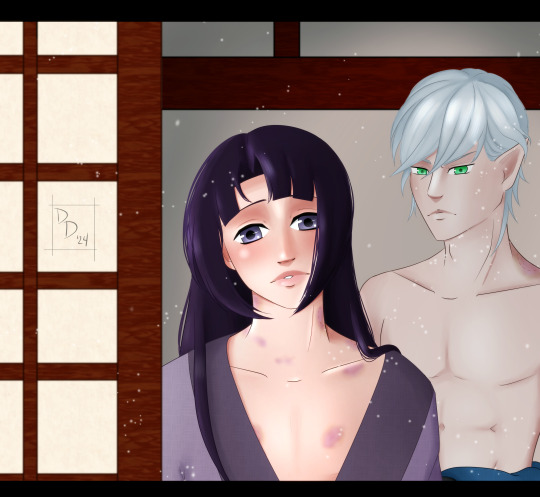
“I’ll tell Hijikata-san you’re, um, occupied. H-have a good day, captain!”
So my hand slipped....
@yugenronin wrote a drabble featuring our boys and the scene at the end, where a poor rank-and-file soldier tries to come collect the captain was so funny I was inspired to draw the scene from his point of view!
You're the best sweetie I love our boys so much.
----
Commissions | Ko-fi | Twitch
#peacemaker kurogane#okita souji#niwa nagahide#sengoku night blood#ship art#my art#artists on tumblr
14 notes
·
View notes
Note
The initial plan was to come to the shrine with some treats. He was gifted a box of manju and he first thought to bring it to Nagahide, but the falling leaves were so pretty, and he couldn't help but want to play in them.... just a little while.

"Nagahide~~ are you here?? I brought some manju!! I'll make us some tea!"

"You're late, Souji."
Nagahide grabbed Souji by the wrist, pulling him close and wrapping an arm around him.
"The sakura in spring, the fireflies in summer, the falling leaves of autumn, or the fresh snow of winter... you are much more beautiful and yet you allow them to distract you."
He had been waiting for Souji, watching from a quiet little corner of the engawa with his haori draped over his shoulders, admiring the seasons himself until he noticed a familiar figure down the path. Seeing the joy on his lover's face, brought about by something as simple as falling leaves, stirred something in his heart. But that did not mean Souji was off the hook for being late.
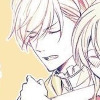
"You kept me waiting. Manju is not enough to make up for it," whispering in Souji's ear, Nagahide lingered for a moment before releasing the smaller man and taking the box of manju from him.
Admittedly, he hadn't eaten yet, so as much as he wanted to tease Souji a bit more... the growling of his stomach exposed one truth.
The other? That all he truly needed was Souji by his side. It did not matter what they did, or even if they did nothing but sit together in silence. Souji himself was more than enough.
7 notes
·
View notes
Text
Nobukatsu's headship of the Oda family after Kiyosu Conference
The state of the Oda clan succession is kind of confusing, with various narratives flying around about what exactly came out of the "Kiyosu Conference". The latest research determined that the official heir is indeed Sanboushi, with Nobutaka and Nobukatsu intended to serve as guardians. The old fashioned narrative of Shibata Katsuie putting up Nobutaka as heir candidate while Hideyoshi supported Sanboushi against him is considered incorrect.
I have finally found more detailed info that seems to confirm the state of the affairs. This is a letter transcript from the 12th month of Tenshou 10 (approximately January 1583):
御状拝見候、よってこの表の儀、三介様御名代に相究め、若子様今日請け取り申し、供奉いたし候、当国不届の仁は曲事に相臥せ、ことごとく一篇に申し付け候条、その御心得あるべく候、はたまた委しき儀森勝申さるべく候、恐〻謹言、 極月廿一日 羽筑秀吉(花押) 惟五郎左長秀(花押) 池勝恒興(花押) 遠山佐渡守殿 同 半左衛門尉殿 御返報 I have read your letter. The Oda administration has decided to appoint Sansuke-sama (Nobukatsu) as the interim head, and as such he has assumed responsibility for Sanbōshi-sama today and joined the ranks of his vassals. Should there be anyone in Mino who does not accept this, we will bring to heel this individual for unlawfulness, and the whole province shall follow suit. Mori Nagayoshi will relay the further details. Respectfully submitted. 12th Month 21st Day Ha-Chiku Hideyoshi (signature) Kore-Goroza Nagahide (signature) Ike-Shou Tsuneoki (signature) In response to: Tooyama Sado no Kami-dono idem, Hanzaemon no Jou
The transcript is quoted from this post, and I unfortunately cannot find where the artifact is or what it looks like. Presumably this post's author took the transcript from a book.
At some point, I had found articles that claimed that Hideyoshi somehow flipped the Kiyosu Conference decision on a later date. He put up Nobukatsu as the actual new clan head, and sidelined Sanboushi. Wikipedia cites the source of this claim from papers from Aichi prefecture's historical archives.
However, we can see now that the claim is not entirely true. It is stated that clearly, the official head is Sanboushi. Nobukatsu is only serving as the interim head/temporary lord in his stead until he is of age. Still, even as just an interim head and not the actual new lord of the clan replacing Sanboushi, this would put him above Nobutaka. It does make sense why Katsuie and Nobutaka would be offended by this decision, and thus led to the Battle of Shizugatake.
Wikipedia claims that this decision to appoint Nobukatsu as the interim head was actually done in the tenth month, quite interestingly not very long after Hideyoshi wrote this exaggerated letter offering to commit seppuku and "follow Nobunaga to death". The cited paperwork (same as the above Aichi prefecture archive material) is unfortunately still paywalled and cannot be viewed online, so I cannot verify this.
Also, a note on the funny-seeming names in the signatures. It is common for people in this time to abbreviate their names and aliases or titles in that manner in letter signatures. "Ha-Chiku" is Hashiba Chikuzen, "Kore-Goroza" is Korezumi Gorozaemon, and "Ike-Shou" is Ikeda Shouzaburou.
Niwa Nagahide was granted the new surname "Korezumi" when he was promoted in 1575.
Tooyama Sado no Kami is Tooyama Toshikage 遠山利景, a lord who holds territory in Mino Province. Hanzaemon no Jou is his son. Notes in the article mentioned that Edo period chronicles from Iemitsu's reign claimed that the Tooyama family had already pledged to serve the Tokugawa at this time. However, since the original inquiry from the Tooyama side (to which this cited letter is a response) is nowhere to be found, we don't know for certain what's really happening here.
#oda nobukatsu#toyotomi hideyoshi#ikeda tsuneoki#niwa nagahide#oda hidenobu#samurai#sengoku#japanese history#sengoku jidai#sengoku era#sengoku period#warring states era#warring states period#warring states#hashiba hideyoshi#sanboshi#sanboushi#letter
5 notes
·
View notes
Text
Hello there Niwa "Manchiyo" Nagahide fans.
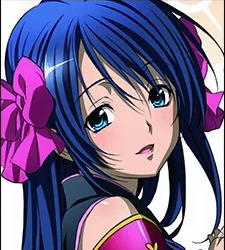
0 notes
Text

Toyonobu
"Shinsentaikoki Niwa Gorozaemon Nagahide"
Two large format Nishiki-e series
Meiji 16 (1883)
9 notes
·
View notes
Text
Ryu Number: The Sengoku Period/Romance of the Three Kingdoms characters of Warriors Orochi 4 Ultimate, Chapter 2, Part 1
The Rescue of Takeda
Kunoichi (くのいち) Female ninja invented by KOEI.
Takeda Shingen (武田 信玄) Major daimyo of the Sengoku Period. Led the Takeda clan. Born 1521. Highly skilled, he famously almost entirely annihilated the combined forces of the Tokugawa clan and the Oda clan at the Battle of Mikatagahara in 1573. Unfortunately, he was unable to fully defeat his foe and had to withdraw. In the later Siege of Noda Castle, he succeeded in taking the castle from Tokugawa forces, but was shot by a sniper, perhaps fatally. He died in the same year (1573).
Sanada Nobuyuki (真田 信之) Samurai. Born 1566. Older brother of Sanada Yukimura. Originally served the Takeda clan under his father. After the Takeda clan was destroyed, this and that happened, but Nobuyuki eventually fell in under Toyotomi Hideyoshi. When Ishida Mitsunari led his uprising at the 1600 Battle of Sekigahara, Nobuyuki, who was married to Tokugawa Ieyasu’s adopted daughter/Honda Tadakatsu’s daughter (that’s one person), served the Eastern Army under Tokugawa, while his Yukimura and his father served the other side. After the Eastern Army won, Nobuyuki was able to secure exile for Yukimura and his father (rather than anything capital). Died 1658.
Sanada Yukimura (真田 幸村; also called Sanada Nobushige/真田 信繁) Born 1567. Served the Takeda clan until their fall, after which he ended up under Toyotomi Hideyoshi. At the 1600 Battle of Sekigahara, joined the Western Army, but his life was spared at the request of his brother Nobuyuki and he was exiled instead of executed. However, at the Siege of Osaka he again joined Toyotomi loyalists against Tokugawa Ieyasu’s forces and was killed there in 1615.
-
Guan Yinping
Liu Bei
Ma Chao
Naoe Kanetsugu
Uesugi Kenshin
-
Hori Hidemasa (堀 秀政) Born 1553. Served Nobunaga, then, after Nobunaga’s death, Toyotomi Hideyoshi, one of Nobunaga’s retainers. Died 1590 of illness.
Kai (甲斐, often suffixed with -hime i.e. Lady) Date of birth unclear—possibly 1572. Originally served the Hōjō clan. In the 1590 Siege of Oshi, wherein Toyotomi Hideyoshi’s forces struck against the Hōjō clan, she defended the castle for over a month with an incredibly small number of men, only surrendering after it was learned that the lord of the castle (Kai’s father) had been defeated elsewhere. She later put down an internal rebellion by sword, impressing Hideyoshi such that he made her his concubine. I guess that was a reward back then. Date of death unknown—she disappears from history after the Siege of Osaka (1615ish), which saw the defeat of the Toyotomi by the Tokugawa shogunate.
Mori Ranmaru (森 蘭丸; also called Mori Naritoshi/森 成利) Attendant of Oda Nobunaga. Served Nobunaga with great devotion. Died in the Honnō-ji Incident.
Niwa Nagahide (丹羽 長秀) Retainer of Oda Nobunaga. Born 1535. Died of illness 1585.
Nō
Oda Nobunaga (織田 信長). Major daimyo of the Sengoku Period. Born 1534. The guy who kickstarted the unification of Japan. He did a dang lot and trying to sum it all up under one entry is more work than I’m up to right now, so suffice to say a lot of people died and it was very interesting and/or dramatic. He was known both for his innovative tactics and his brutal behavior toward the uncooperative. His also-famous retainers were Toyotomi Hideyoshi and Tokugawa Ieyasu. He died 1582 in the Honnō-ji Incident when his vassal Akechi Mitsuhide rebelled—after being wounded and made unable to fight further, he committed suicide (possibly; it was a big ruckus so exactly how he died is unclear).
Sakuma Nobumori (佐久間 信盛) Retainer of the Oda clan. Born 1528. Was entrusted with the care of Oda Nobunaga. Despite this, in 1580, he received a formal chastisement from Nobunaga for Not Being Good At His Job and was dismissed (de facto exiled), and would die in 1582. There are opinions regarding whether this dismissal was deserved.
Sassa Narimasa (佐々 成政) Samurai lord. Born 1536. Served Oda Nobunaga through the latter’s career. Eventually ended up serving Toyotomi Hideyoshi. For his services he was granted Higo Province, but after he was unable to quell an uprising there on his own he was ordered by Hideyoshi to commit suicide, which he did in 1588.
Akechi Hidemitsu (明智 秀満) Retainer to Akechi Mitsuhide, which isn’t confusing at all. Married to a daughter of Akechi Mitsuhide. Led the attack against Nobunaga at Honnō-ji. Famously cut across Lake Biwa with his horse after Akechi Mitsuhide’s defeat at the 1582 Battle of Yamazaki, then committed ritual suicide at Sakamoto Castle. Died 1582. The character Akechi Samanosuke in the Onimusha series is based on him, but probably not intended to be literally the same individual.
Akechi Mitsuhide (明智 光秀) Born 1528. Served Oda Nobunaga, but is best known for his assassination. In 1582, he was ordered by Nobunaga to assist Toyotomi Hideyoshi against the Mōri clan, but instead rebelled and attacked Nobunaga at Honnō-ji (translator’s note: “ji” means “temple”). The reasons for his actions are unclear at best. With less support and more enemies than he apparently anticipated, Mitsuhide was killed in 1582 fleeing (as did his forces) from the Battle of Yamazaki.
Saitō Toshimitsu (斎藤 利三; some sources give his given name as “Toshikazu”) Vassal of Akechi Mitsuhide. Born 1534. Sided with Mitsuhide in the Honnō-ji Incident. Captured and executed accordingly in 1582.
Asahina Yasutomo (朝比奈 泰朝) Vassal of the Imagawa clan. After Yoshimoto’s death, continued to serve his heir Imagawa Ujizane (Ujizane was actually the one who notably enjoyed playing kemari, not Yoshimoto).
Imagawa Yoshimoto
Okabe Motonobu (岡部 元信) Vassal of Imagawa Yoshimoto. Even after Yoshimoto was killed in the 1560 Battle of Okehazama, he refused to stop fighting, which apparently impressed Nobunaga such that he returned Yoshimoto’s head. Afterward, Motonobu served the Takeda clan and died in 1581 in the Seige of Takatenjin, falling to Tokugawa forces.
Fūma Kotarō (風魔 小太郎) The name taken on by each head of the Fūma clan, which specialized in guerrilla warfare and espionage. The fifth leader of the clan is the pertinent one here. Served the Hōjō clan. Forced to surrender with the Hōjō clan after the latter’s defeat at the 1590 Siege of Odawara at the hands of Toyotomi Hideyoshi. The Fūma clan were reduced to brigands, and Fūma Kotarō was eventually captured and executed by Tokugawa Shogunate forces in 1603. That said, it’s really not clear how much of this guy is actual history and how much is folklore, which is itself very ninja, so good job, I guess.
Hōjō Tsunashige (北条 綱成; given name possibly “Tsunanari”) Born 1515. Initially a vassal of the Imagawa clan, he joined the Hōjō clan and became the brother-in-law of Hōjō Ujiyasu (third head of the Hōjō clan). He managed to retire and died 1587.
Hōjō Ujinao (北条 氏直): Final head of the Hōjō clan. Born 1562. He tried to take advantage of the chaos after the Honnō-ji incident, but ended up defeated by Tokugawa Ieyasu and banished. Died 1591.
Hōjō Ujiyasu (北条 氏康) Head of the Hōjō clan. Born 1515. Conflicts began between the Hōjō clan and the Takeda clan toward the end of Ujiyasu’s life, but he was able to hammer out a truce between the Hōjō and Uesugi Kenshin and the Hōjō and Takeda Shingen. He died in 1571. His heir was Hōjō Ujimasa.
-
Hou Yin (侯 音, Kou On) Subordinate of Cao Cao. In 218, Cao Cao sent his younger second cousin Cao Ren to Wan (present day Nanyang, Henan) to prepare an attack on Guan Yu. However, Cao Ren’s policy of conscription and forced labor led to an uprising led by Hou Yin. Cao Ren put down the rebellion and Hou Yin was killed in 219.
Hu Juer (胡 車兒, 胡 車児, Ko Shaji, often translated Hu Che'er or Huche’er, the latter used by Warriors Orochi 4) Aide of minor warlord Zhang Xiu. In Romance of Three Kingdoms, when Zhang Xiu strikes against Cao Cao, Cao Cao’s guard Dian Wei is a really tricky piece to get around. Hu Juer is the one who comes up with a plan that gets Dian Wei drunk so that he can steal his weapons; this leads to Dian Wei’s death in the ensuing battle. Not to be confused with unrelated Three Kingdoms individual Hu Che’er (胡 赤兒), who served and betrayed Niu Fu (who served Dong Zhuo).
Jia Xu (賈 詡, Ka Ku). Born 147. Originally served Dong Zhuo and advised in the takeover of the imperial capital after Dong Zhuo’s death. He eventually left and served minor warlord Zhang Xiu as advisor instead; after Zhang Xiu surrendered to Cao Cao he became one of Cao Cao’s strategists. Made major contributions in this way, and helped secure Cao Pi as Cao Cao’s heir. Died 223.
Zhang Quan (張 泉, Chou Sen; also translated Zhang Chuan) In 219, when Cao Cao was away from the capital on a campaign against Liu Bei, a government official of Cao Wei, Wei Feng, plotted a rebellion, but one of the conspirators got cold feet and reported the plan to Cao Pi, Cao Cao’s heir. Zhang Quan was one of the people who was implicated and executed.
Zhang Xiu (張 繡, 張 繍, Chou Shuu) Initially a minor warlord who stood against Cao Cao. His uncle, Zhang Ji, served Dong Zhuo, and he was part of the coup after Dong Zhuo’s death that took over the imperial capital. He was angered when Cao Cao took Zhang Ji’s widow as concubine. The war between Zhang Xiu and Cao Cao ended in 200 when Zhang Xiu listened to his advisor Jia Xu and surrendered, after which he served Cao Cao with distinction—go fig. Father of Zhang Quan. Died 207 en route to join Cao Cao in his northern campaign against Wuhuan tribes.
Zhao Yan (趙 儼, Chou Gen) Born 171. Joined Cao Cao after he “took in” Emperor Xian. Known for his strictness in enforcing law. Continued to serve under Cao Pi, Cao Rui, and Cao Feng. Died 245.
The Rescue of Uesugi
Aya[-Gozen] (綾 [御前]; translator’s note: “-Gozen” means “Lord”): Born 1524. Half-sister of Uesugi Kenshin, mother of Uesugi Kagekatsu through Nagao Masakage. Died 1609.
-
Naoe Kanetsugu
-
Uesugi Kagekatsu (上杉 景勝): Born 1556. Uesugi Kenshin’s nephew through Kenshin’s sister Aya. After his father died, Kenshin adopted him. When Kenshin died in 1578, the inheritance was supposed to go to Kenshin’s other adopted son, Uesugi Kagetora, but Kagekatsu defeated him and took it for himself. He later married a daughter of Takeda Shingen. Kagekatsu was defeated by Oda Nobunaga’s forces, but Nobunaga’s death granted him an unexpected reprieve, and Kagekatsu stayed alive to fight another day. Kagekatsu was one of the Council of Five Elders Toyotomi Hideyoshi set up to ensure that his chosen heir, Hideyori, succeed him; when the Sekigahara Campaign occurred between Ishida Mitsunari’s Western Army and Tokugawa Ieyasu’s Eastern Army, Kagekatsu sided with Mitsunari, but was defeated early and went to serving Tokugawa. Died 1623.
-
Yukimura Sanada
-
Nagamasa Asano (浅野 長政): Born 1546. Served Oda Nobunaga and Toyotomi Hideyoshi. Under Hideyoshi, held seniority over the Five Commissioners, who governed Kyoto and surrounding areas. Assisted in Hideyoshi’s failed invasions of Korea. Died 1611.
-
Hachisuka Koroku
-
Hosokawa Fujitaka (細川 藤孝): Born 1534. Originally a retainer of the last Ashikaga shogun, Ashikaga Yoshiaki, but when Nobunaga and Yoshiaki clashed, he joined Nobunaga. Refused to support Akechi Mitsuhide after Mitsuhide killed Nobunaga, even though his son was married to Mitsuhide’s daughter. He shaved his head and became a Buddhist monk, taking on the name “Yūsai” (幽斎) and handing his responsibilities to his son. During the Sekigahara Campaign, in 1600, he was in command of Tanabe Castle when it came under siege by Western Army forces (his son was away as part of Tokugawa Ieyasu’s Eastern Army); it’s said that the Western Army attackers, having great respect for Fujitaka, staged an ineffective attack. Died 1610.
Kani Saizō (可児 吉長, also called Kani Yoshinaga/可児 吉長): Born 1554. Skilled with the spear. Served various vassals of Oda Nobunaga. Also served Oda Nobutaka, but after Nobutaka fought against Toyotomi Hideyoshi and then committed suicide, he served the nephew and retained of Hideyoshi, Toyotomi Hidetsugu, but eventually left after Hidetsugu saw defeat at the 1584 Battle of Komaki and Nagakute (part of a power struggle between Hideyoshi and Oda Nobukatsu, with Tokugawa Ieyasu supporting Nobukatsu) and became a masterless samurai (i.e. ronin). Fought in the Battle of Sekigahara in the Eastern Army under Fukushima Masanori. A devotee of the kami Atago Gongen, he is said to have foreseen that he would die on the day of Atago Gongen’s festival, and did so in 1613.
-
Kuki Yoshitaka
-
Kuwayama Shigeharu (桑山 重晴): Born 1524. Served Niwa Nagahide, vassal of Oda Nobunaga. Joined Tokugawa Ieyasu’s Eastern Army in the Battle of Sekigahara. Died 1606.
Oda Nobukatsu (織田 信雄, forename possibly “Nobuo”): Born 1558. Second son of Oda Nobunaga. Became an adopted heir of the Kitabatake clan and ensured his position as head with violence. Was unsuccessful and incompetent as a general, but a skilled fighter. After Nobunaga’s death, he and his brother Nobutaka quarreled over succession, leading a council to decide on the infant Oda Hidenobu instead. Toyotomi Hideyoshi supported him, and he initially joined with Hideyoshi to fight Nobutaka, but eventually a power struggle occurred between Nobukatsu and Hideyoshi, too, and he allied with Tokugawa Ieyasu’s force to fight against Hideyoshi in the 1584 Battle of Komaki and Nagakute. Became the guardian of Hideyoshi’s son and successor, Toyotomi Hideyori, in 1598, but walked out on him directly before the 1614 Siege of Osaka, cooperating with Ieyasu. Lived the rest of his life comfortably and died 1630.
Oda Nobutaka (織田 信孝, forename possibly “Nobunori”): Born 1558. Third son of Oda Nobunaga. Was adopted into the Kanbe clan and became its eighth head. After Nobunaga’s death, he quarreled over succession with his brother Nobukatsu. Tensions between Nobutaka and Nobukatsu eventually came to violence when Nobutaka tried to start a war against Toyotomi Hideyoshi (who supported Nobukatsu). He lost and was forced to commit suicide in 1583.
Yamauchi Kazutoyo (山内 一豊, forename possibly “Katsutoyo”): Born 1545 or 1546. Served Oda Nobunaga, then Toyotomi Hideyoshi. In the Battle of Sekigahara, served Tokugawa Ieyasu’s Eastern Army. Died 1605.
-
Li Fei (黎 斐, Rei Hi) Served Wu under the regent Sun Chen (“under” Sun Liang). Some background: In 249, Sima Yi, regent of young Cao Wei emperor Cao Fang, overthrew his fellow co-regent Cao Shuang in a coup (referred to as the Incident at the Gaoping Tombs). After this, Cao Wei’s power began to fall into the hands of the Sima family. Sima Yi was followed by his son Sima Shi (who deposed Cao Fang in 254 and replaced him with Cao Mao), who was followed by another son of Sima Yi’s, Sima Zhao. Various rebellions occurred against the Simas, but it always ended badly for the rebels and loyalists, which made Cao Wei general Zhuge Dan real antsy until he staged his own rebellion against Sima Zhao in 257. Anyway, Sun Chen of Wu supported Zhuge Dan’s rebellion (but really messed it up in various ways), and Li Fei led some of the Wu forces.
Lü Ju (呂 據, 呂 拠, Ryo Kyo): Served Sun Quan of Wu. Lü Ju was one of the men Sun Quan placed to guide his heir, Sun Liang, after Sun Quan’s death (Zhuge Ke, meanwhile, was regent). You might remember that Sun Jun killed Zhuge Ke and assumed regency. In 256, Sun Jun ordered Lü Ju and other generals to attack the Xu and Qing provinces under Wei. However, shortly after the army started out, Sun Jun took ill and died, and his duties were taken over by his cousin, Sun Chen. Apparently, this distressed Lü Ju, who suggested with some other folks that Sun Chen be removed from power. Sun Chen objected, hilarity ensued, and Lü Ju ended up committing suicide. And then Sun Chen killed his whole family. Great going.
-
Sun Quan
Sun Shao
-
Taishi Ci (太史 慈, Taishi Ji): Born 166. Han official who ended up serving Wu. Originally a minor official of the Donglai Commandery. Rescued minor warlord Kong Rong, the Chancellor of Beihei State, from Yellow Turban rebels, to repay the aid his mother had received from Kong Rong in the past. Tried to establish his own power base but was defeated by Sun Ce’s forces. He then willingly served Sun Ce. After Sun Ce was assassinated, he served his successor, Sun Quan. Died in 206. In Romance of the Three Kingdoms, he gets a more dramatic end, dying in the 208 Battle of Hefei (this occurred between Sun Quan and Cao Cao as part of the Red Cliffs Campaign).
Taishi Xiang (太史 享, Taishi Kyou) Served Wu. Son of Taishi Ci. Served Sun Quan; was appointed to various posts. In fiction, Sun Quan looks after him after the death of his father.
Li Tong (李 通, Li Tsuu): Born 168. Served Cao Cao of Wei. Saved Cao Cao’s rearguard in the retreat from Zhang Xiu in 197. Broke through Guan Yu’s defenses in the 208 Battle of Jiangling and supported Cao Ren, but died of illness during the campaign in 209.
Xu Huang (徐 晃, Jo Kou): Served Cao Cao of Wei. One of the individuals responsible for secreting Emperor Xian out of Li Jue and Guo Si’s control. During this time, he still served Yang Feng, a former bandit who served as a general under the Han government. His most successful moment was when he led a force to break Guan Yu’s siege of Fancheng in 219 (this was the start of the circumstances directly leading to Guan Yu’s capture and death by Sun Quan—at this point Cao Cao and Sun Quan were allied). He would later serve under Cao Pi and Cao Rui before dying in 227. In Romance of the Three Kingdoms, he’s killed during the Xincheng Rebellion by Meng Da (a rebelling Wei general).
Xu Shang (徐 商, Jo Shou): Served Cao Cao of Wei. At the 219 Battle of Fancheng, he supported Xu Huang against Guan Yu.
Yin Shu (殷 署, In Sho): Served Cao Cao of Wei. In 215, after the troops of Han Sui (a warlord who had rebelled against Cao Cao) were placed under his authority, they rebelled against Yin Shu, but Yin Shu survived. At the 219 Battle of Fancheng, supported Xu Huang.
Zhai Yuan (翟 元, Teki Gen): A fictional character in Romance of the Three Kingdoms. Serves Cao Ren at the Battle of Fancheng and is killed by Guan Yu’s son, Guan Ping.
Zhu Gai (朱 蓋, Shu Gai): Served Cao Cao of Wei. At the 219 Battle of Fancheng, supported Xu Huang.
The Collapse of Oda’s Allied Forces
Ii Naomasa
Ii Naotora
Kunoichi
Takeda Shingen
Uesugi Kagekatsu
Asahina Nobuoki
Asahina Yasutomo
Imagawa Yoshimoto
Okabe Motonobu
-
Saika Magoichi (鈴木 孫一): A name inherited by the leader of one of the Saika Ikki (translator’s note: “Ikki” means “uprising” or “revolt”) groups. The Saika Ikki was one of a number of Ikkō-ikki sects (translator’s note: Ikkō was a small, militant offshoot of Jōdo Shinshū Buddism) (translator’s note: Jōdo Shinshū is a school of Jōdo Buddhism) (translator’s note: Jōdo Buddhism is a broad branch of Mahayana Buddhism focused on achieving rebirth in the Pure Land) made up of various peasants and merchants and the like. They were backed up by, uh, those particular Buddhists I mentioned parenthetically up there, and opposed daimyo rule. The relevant Saika Magoichi here was Suzuki Shigehide (鈴木 重秀). He famously fought against Oda Nobunaga in support of various opposed parties until those opposed parties—and the support they provided—petered out.
[Hosokawa] Gracia ([細川] ガラシャ; that katakana spells “Garasha”): Born 1563. Daughter of Akechi Mitsuhide. “Gracia” was her baptismal name after she converted to Christianity; her original name was “Tama” or “Tamako.” Married Hosokawa Tadaoki, son of Hosokawa Fujitaka. After her father betrayed and killed Oda Nobunaga, she was confined, but like in a “kept to mansion grounds” kind of way. Secretly converted to Catholicism even after Toyotomi Hideyoshi issued a proclamation against Christianity. When conflict broke out between Tokugawa Ieyasu and Ishida Mitsunari after Hideyoshi’s death, Mitsunari attempted to take Gracia hostage as part of a general plan to secure compliance of enemy generals, but everyone at the place went for suicide instead (except for Gracia—because Catholicism—who was killed by her retainer). This further did-not-endear Mitsunari to potential allies, possibly sealing his fate.
-
Jia Xu
Taishi Ci
Zhu Ran
-
Diaochan (貂蟬, Chousen): In real life, official Wang Yun organized a coup against Dong Zhuo with Lü Bu; one of the reasons Lü Bu and Dong Zhuo had fallen out was a quarrel over a woman in Dong Zhuo’s harem. Romance of the Three Kingdoms jazzes up the whole situation, inventing Diaochan, adopted daughter of Wang Yun. In fiction, Wang Yun and Diaochan set Dong Zhuo up, setting him and Lü Bu as the far sides of a love triangle with Diaochan in the middle, deliberately stirring up Bad Feelings between the two of them until Lü Bu is Very Inclined toward Wang Yun’s coup plans. As she’s a fictional character, her ultimate fate differs from folktale to folktale.
-
Dong Zhuo
-
Ju Shou (沮 授, So Ju; occasionally in Japanese as “Sho Ju”): Advisor under warlord Yuan Shao. Known for giving Yuan Shao good advice which Yuan Shao then ignored. Examples: Advised Yuan Shao to take in Emperor Xian and utilize his authority—he didn’t, and then Cao Cao did that instead, which was good for Cao Cao. Advised Yuan Shao that an all-out attack against Cao Cao was a Bad Idea and he ought to adopt a strategy of wearing him out over time—Yuan Shao did it anyway, and lost the 200 Battle of Guandu. Ju Shou was captured by Cao Cao in this battle and Cao Cao treated him decently, but remained thoroughly loyal to Yuan Shao and was killed by Cao Cao’s men when he tried to escape.
Wen Chou (文 醜, Bun Shuu): Served under Yuan Shao. At the 200 Battle of Yan Ford between the forces of Yuan Shao and Cao Cao, he was killed, possibly by Guan Yu (who was serving Cao Cao at that time).
Yan Liang (颜 良, 顏 良, 顔 良, Gan Ryou): Served under Yuan Shao. At the 200 Battle of Boma between the forces of Yuan Shao and Cao Cao, he was killed by Guan Yu (who was serving Cao Cao at that time).
Yuan Shao (袁 绍, 袁 紹, En Shou): During the civil wars at the end of the Han Dynasty, he controlled the northern territories of China. Spearheaded a coalition of warlords against Dong Zhuo when Zhuo was essentially holding Emperor Xian hostage, but it turns out warlords don’t coalite very well. Campaigned against Cao Cao, but lost battle after battle and died in 202 before he could properly set up succession, leaving his territories contested among his sons, which didn’t help them not also get defeated by Cao Cao. Cao Cao respected him and reportedly wept at his tomb.
Yuan Xi (袁 煕, En Ki): Second son of Yuan Shao. Following the 200 Battle of Guandu and the defeat of Yuan Shao’s forces by Cao Cao’s he fled to the Liaodong Peninsula, taking shelter with its administrator, Gongsun Kang. Kang’s domain was semi-independent, but he decided to curry favor with Cao Cao anyway, executing Yuan Xi in 207 and sending Cao Cao his head. He was married to Lady Zhen, who Cao Pi took as his own wife while Yuan Xi was still alive.
-
Lü Bu
Chaos Incarnate
Kunoichi
Sanada Yukimura
Takeda Shingen
Gracia
Fūma Kotarō
-
Haga Ujitsugu (垪和 氏続): Vassal of the Hōjō clan. When Takeda Shingen broke the alliance between the Takeda and Hōjō clans in 1568, he valiantly defended Kōkokuji Castle. He participated in the 1582 Battle of Kanagawa between Hōjō and Oda forces following the death of Oda Nobunaga, but his actions after are unclear at best.
Haga Yasutada (垪和 康忠): Vassal of the Hōjō clan. Helped hammer out the alliance between the Takeda, Hōjō, and Imagawa clans. His movement after the fall of the Hōjō clan are unknown.
-
Hōjō Tsunashige
-
Inomata Kuninori (猪俣 邦憲): Vassal of the Hōjō clan. After Toyotomi Hideyoshi issued an order forbidding private warfare among the daimyo, he was directly involved in the taking of Nagurumi Castle (which belonged to the Sanada clan). This led to Hideyoshi’s destruction of the Hōjō clan. What happened to Kuninori afterward is unclear.
Ishimaki Yasumasa (石巻 康敬): Born 1534. Vassal of the Hōjō clan. After the fall of the Hōjō clan, he eventually ended up with Tokigawa Ieyasu. Died 1613.
-
Kai
-
Kasahara Masaharu (笠原 政晴; Warriors Orochi 4 calls him Kasahara Masataka/笠原 政尭, which is apparently a historical error that’s percolated?): Vassal of the Hōjō clan. After the alliance broke between the Hōjō and Takeda clans, he defected to the Takeda in 1581 and even fought against his own family, but after the Takeda were defeated he returned to the Hōjō. During Toyotomi Hideyoshi’s Siege of Odawara in 1590, he was caught attempting to surrender by his brother and killed accordingly.
Lady Hayakawa (早川 殿; that last kanji is the honorific suffix “-dono”): One of the daughters of Hōjō Ujiyasu. As part of the alliance between the Takeda, Hōjō, and Imagawa clans, she married Imagawa Ujizane, Imagawa Yoshimoto’s son. After the alliance fell apart, the two of them ended up with Tokugawa Ieyasu. Died 1613.
Nagao Akinaga (長尾 顕長): Became head of the Nagao clan. His territory was caught between the Uesugi and Hōjō, but he eventually ended up solidly on the Hōjō side. Around 1589, he fell out with the Hōjō chan, though, and lost his territory. He defended Odawara Castle in 1590. Afterward, he became a wanderer and died in 1621.
Narita Nagatada (成田 長忠; also called Yasuchika/泰親): After the defeat of the Hōjō by Toyotomi Hideyoshi, he and his brother, Narita Ujinaga, were entrusted to one of Hideyoshi’s men, Gamō Ujisato. With his brother, assisted in the Kunohe rebellion, in which the forces of Hideyoshi and Tokugawa Ieyasu completed the unification of Japan through the killing of folks who didn’t particularly want to be unified. When Ujinaga died, he took over his stuff. He was in the Eastern Army in the 1600 Battle of Sekigahara. Died 1617.
Narita Ujinaga (成田 氏長): Father of Kai; older brother of Narita Nagatada. Born 1542. Originally a vassal of Uesugi Kenshin, he was later aligned with the Hōjō clan. After the defeat of the Hōjō by Toyotomi Hideyoshi, he and his daughter were placed in the care of one of Hideyoshi’s men, but Ujinaga eventually got into Hideyoshi’s graces (the relationship between Hideyoshi and Kai probably helped). Died 1596.
Ogasawara Yasuhiro (小笠原 康広): Born 1531. Vassal of the Hōjō clan. After Toyotomi Hideyoshi defeated Hōjō Ujinao in 1590, he followed the latter to exile until Ujinao’s death. Afterward, he served Tokugawa Ieyasu. Died 1598.
Tominaga Naokatsu (富永 直勝): Born 1509. Vassal of the Hōjō clan. In the Second Battle of Kōnodai in 1564 against the Satomi clan, he crossed the Edo River well ahead of the main body of the army and was killed. It’s said that he did this out of guilt for not being able to catch the defection of Ōta Yasusuke to Uesugi Kenshin. Ironically, this meaningful gesture served only to muck up Hōjō Tsunashige’s battle plans, though Tsunashige did manage to work out a victory anyway.
Ueda Norisada (上田 憲定): Born 1546. Vassal of the Hōjō clan. He was present at the Siege of Odawara in 1590 when Odawara Castle fell to Toyotomi Hideyoshi. What happened to him following those events is unclear, but he’s reported to have died 1597.
-
Fa Zheng
Guan Yinping
-
Xiahou Ba (夏侯 霸, 夏侯 覇, Kakou Ha): Son of Xiahou Yuan, a prominent general under Cao Cao. After Yuan was killed in the 219 Battle of Mount Dingjun at the hands of a Shu general, Ba swore revenge. He continued to serve the Cao Wei; however, in 249, the Incident at the Gaoping Tombs occurred wherein regent Sima Yi had the other regent Cao Shuang executed and effectively seized Cao Wei for himself. This was pretty bad for those who might have been politically aligned with Cao Shuang, and Xiahou Ba elected to defect to Shu. There, he befriended another defector from Cao Wei to Shu, Jiang Wei, and joined him on campaigns against Cao Wei. His date of death is unknown, but occurred between 255 and 259. In Romance of the Three Kingdoms, he is killed in the final invasion of Shu by Cao Wei forces (in 263) that marked the end of the Shu state.
-
Xu Huang
Yuan Shao
Lü Lingqi
The Rescue of Liu Bei
Sanada Yukimura
Noatora Ii
Uesugi Kenshin
Lady Hayakawa
Akechi Mitsuhide
-
Dom Justo Takayama (indicated in-game as Takayama Shigetomo/高山 重友 and also known as Takayama Ukon/高山 右近): Born c. 1552/1553; in 1564 his father converted to Roman Catholicism and he was baptized “Justo.” Served under Oda Nobunaga and Toyotomi Hideyoshi during the Sengoku period. Relating to his Christianity, his position allowed him and his father to facilitate the conversion of subjects and detroy Buddhist and Shinto shrines in their territories. When Hideyoshi ordered the expulsion of Christian missionaries and that Christian daimyo renounce their faith, Justo refused gave up his lands and possessions instead, living under the care of previous comrades, effectively in exile. When Tokugawa Ieyasu expelled Christians in 1614, he left for Manila (the Philippines then being Spanish territory), but died there in 1615; afterward, his family was allowed to return to Japan.
-
Gracia
Hori Hidemasa
Hosokawa Fujitaka
Mori Ranmaru
Nō
Oda Nobunaga
Sakuma Nobumori
-
Sakuma Yasumasa (佐久間 安政): Born 1555. Served Oda Nobunaga. Worked under Sakuma Nobumori for some time. During the succession dispute following Oda Nobunaga’s death, Yasumasa fought in the 1583 Battle of Shizugatake on the side of Shibata Katsuie and Oda Nobutaka against Toyotomi Hideyoshi and Oda Nobukatsu. He took shelter among various sides opposing Hideyoshi in the following years, but Hideyoshi pardoned him after 1590 and he eventually became his vassal. Fought in the Eastern Army in the 1600 Battle of Sekigahara. Died 1627.
-
Sassa Narimasa
-
Shibata Katsuie (柴田 勝家): Born 1522, or maybe 1526 or 1527. Trusted general of Oda Nobunaga. He originally served under Nobunaga’s younger brother, Oda Nobuyuki, and fought for Nobuyuki when he and Nobunaga clashed over control of the Oda clan; Nobuyuki lost and was executed, but Nobunaga was impressed with Katsuie, who pledged himself to Nobunaga. After Nobunaga’s death and the following succession crisis, Katsuie eventually sided with Nobunaga’s third son, Oda Nobutaka, against Toyotomi Hideyoshi and Oda Nobukatsu. When he was defeated in the 1582 Battle of Shizugatake, he retreated to Kitanosho Castle, where he and his wife, Oichi (the younger sister of Nobunaga) committed suicide.
Shibata Katsumasa (柴田 勝政): Born 1557. He was Shibata Katsuie’s nephew through his mother, as well as Katsuie’s adopted son. All indications are that he died at the 1582 Battle of Shizugatake, but there is a legend that he survived, changed his name to Shibano, and died in 1641 in the town of Sadamitsu (merged into the town of Tsurugi since 2005).
-
Yamauchi Kazutoyo
-
Guan Ping (關 平, 関 平, Kan Pei): Eldest son of Guan Yu who served under Liu Bei (in Romance of the Three Kingdoms, he’s the son of a farmer who impresses Guan Yu, who subsequently fosters him). After Sun Quan’s Wu forces, led by Lü Meng, invaded Liu Bei’s Jing Province, he and his father were captured and executed in 220.
-
Fa Zheng
Liu Bei
Ma Chao
-
Xu Shu (徐 庶, Jo Sho): Originally a vigilante who gave up the sword and became a reclusive scholar in Wei. Settled in Shu’s Jing Province in the early 190s. Became an advisor to Liu Bei; also recommended Zhuge Liang to Liu Bei as an advisor. He joined Liu Bei, but after Cao Cao’s forces defeated Liu Bei’s at the 208 Battle of Changban and Xu Shu’s mother was among those captured, he left to serve Cao Cao He lived through Cao Pi’s reign and died in the 230s during the reign of Cao Rui. Romance of the Three Kingdoms dramatizes Xu Shu’s circumstances: Cao Cao wants to poach Xu Shu, so he captures Xu Shu’s mother and orders her to write Xu Shu to join her. She refuses, so he has his advisor Cheng Yu hang around Xu Shu’s mother until he’s good enough to mimic her handwriting and write Xu Shu himself. Xu Shu falls for it, and Xu Shu’s mother commits suicide out of shame. Xu Shu remains with Cao Cao, but refuses to ever give Cao Cao any advice.
Zhang Fei (張 飛, Chou Hi): Follower of Liu Bei basically from the beginning (in The Romance of the Three Kingdoms, he’s one of Liu Bei’s sworn brothers along with Guan Yu). He was a skilled military leader, though fiction makes him a mite unintelligent. After Sun Quan broke his alliance with Liu Bei in 219 (invading Jing Province, which resulted in Guan Yu’s death), Liu Bei launched a campaign to strike back; Zhang Fei was sent to lead troops, but two of his subordinates assassinated him and took his head as they defected to Sun Quan’s side.
-
Lianshi
-
Chen Tai (陳 泰, Chin Tai): Military general of Wei. In 260, Cao Mao died in a futile attempt to take his imperial power back from the “regent” Sima Zhao. Chen Tai wept and initially refused to attend coirt sessions. During the attempted ousting, Cao Mao had died by spear personally at the hands of officer Cheng Ji, but with Cheng Ji following the instructions of Sima Zhao’s aide Jia Chong; Chen Tai recommended that Jia Chong be executed for regicide accordingly, but Sima Zhao executed Cheng Ji instead. Chen Tai died soon afterward, in some recountings of the event of suicide or despair.
Guo Huai (郭 淮, Kaku Wai): Military general of Wei. Initially served under Xiahou Yuan and Zhang He during Cao Cao’s reign. Additionally, lived during the reigns of Cao Pi, Cao Rui, Cao Fang, and Cao Mao. Failed to participate in the initial campaign of Liu Bei to take Hanzhong Commandery from Cao Cao due to illness. Notably fell sick and was consequentially late to Cao Pi’s coronation, which led Cao Pi to not-threaten him with execution, which Guo Huai fended off with a clever response that got him promoted. Studied potential enemies/vassals beforehand to win them over diplomatically. A major figure when it came to fighting the Shu and resisting their invasions. In 251, when Wei general Wang Ling launched a failed rebellion, it was ordered that all relatives of Ling be executed; this included Guo Huai’s wife. Guo Huai reluctantly refused to request his wife’s pardon, and only begged the Wei regent Sima Yi after he was moved by the pleas of his sons (she was spared). Died 255; in Romance of the Three Kingdoms, he’s killed by an arrow of Jiang Wei’s during Shu’s (unsuccessful) 253 invasion.
Sima Zhao (司馬 昭, Shiba Shou): Born 211. Regent of Wei emperors Cao Mao and Cao Huan. I mean, I say “regent,” but he held all the power. His father, Sima Yi, and his brother, Sima Shi, were similarly “regents” for Mao’s predecessor Cao Fang, with Sima Yi having fully turned regency into “regency” during Cao Fang’s “reign.” Sima Zhao took over for “regenting” for Cao Mao after the previous “regent” Sima Shi died in 255. In 262, Cao Mao attempted to regain his power in a rebellion and was killed; Sima Zhao subsequently had Cao Huan, Cao Mao’s first cousin once removed, become puppet emperor instead. In 262, he launched an invasion of Shu, which was by this time weakened by having carried out numerous failed campaigns against Wei; this invasion ended in the surrender of Shu emperor Liu Shan and the fall of the Shu state. He died in 265, all but having named himself emperor; his son, Sima Yan, would finally formally usurp Cao Huan and establish the state of Jin (retroactively formalizing Sima Zhao an emperor).
Wang Yuanji (王 元姬, 王 元姫, Ou Genki): Born 217. Noble and wife of Sima Zhao. When her son Sima Yan forced Wei emperor Cao Huan to abdicate and proclaimed himself emperor of Jin, she formally became empress dowager; however, she continued to live a simple and frugal lifestyle. Died 268.
-
Xiahou Ba
-
Xiahou Xuan (夏侯 玄, Kakou Gen): Born 209. He was related to Xiahou Ba but refused to follow him to Shu after Sima Yi staged his coup and seized power as a “regent.” Having been aligned with Sima Yi’s political opponents, he wasn’t treated all that well. Around 254, Li Feng, who held a position in the Wei government, sought to overthrow Sima Shi (who had followed Sima Yi) and put the power in the emperor Cao Fang’s hands. Xiahou Xuan was part of this plot; however, Sima Shi found out before it could be enacted and Xiahou Xuan was executed.
Xin Chang (辛 敞, Shin Shou): An official of Wei, and a subordinate of Cao Shuang. When regent Sima Yi made his move against other-regent Cao Shuang in 249, taking the capital, Xin Chang asked his older sister, Xin Xianying, for advice, and she told him that as one of his Cao Shuang’s men, he was obligated to go to Cao Shuang’s aid. Following the whole shebang, Xin Chang was pardoned from execution, having been recognized as only following his duty.
Zhuge Dan (諸葛 誕, Shokatsu Tan): Military general of Wei. The rising power of the Sima clan (“regents” of the Wei emperors) and their tendency to purge (politically, I mean) made him so antsy that he decided he’d do his own rebellion against Sima Zhao in 257. Wu helped a little but left when it became clear it wasn’t going to be any good, and Zhuge Dan was killed attempting to break out of a siege in 258.
1 note
·
View note
Photo

Requested work >> https://skeb.jp/@shikei/works/4
350 notes
·
View notes
Text
Glad you liked it! It's one of my favorite bits of Setsubun trivia. And like I said, Lord Niwa was the descendant of Oda Nobunaga's clan elder Niwa Nagahide, so he probably came by his self-consciousness honestly.
-Nyri
It was very funny to hear in @cleyerapodcast 's latest episode about Lord Niwa getting mad about the typical Setsubun saying "Oni wa soto, fuku wa uchi" (Bad luck/Onis out, good fortune in) because it sounded like "Niwa soto" (Get out, Niwa).
7 notes
·
View notes
Photo

Happy Birthday Maeno Tomoaki ❤️❤️❤️❤️🎂💐🎉🎊
#Maeno Tomoaki#Camus#Yamanbagiri Kunihiro#Nagahide Niwa#José Martínez#Yoshihito Usaida#Bunchuu#Theo Colton#Tsurane Toomi#Ryousuke Kase#Shuu Kuga#Hajime Tenga#Son Hak#Natsume Asahina#Akira Tachibana#Leon Lau#Dino#Kousuke Ooshiba#Arsene Lupin#Happy Birthday
47 notes
·
View notes
Photo
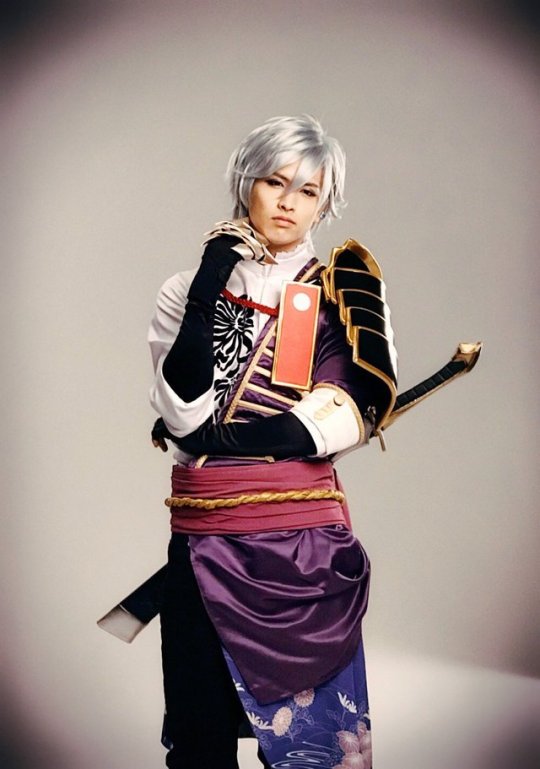
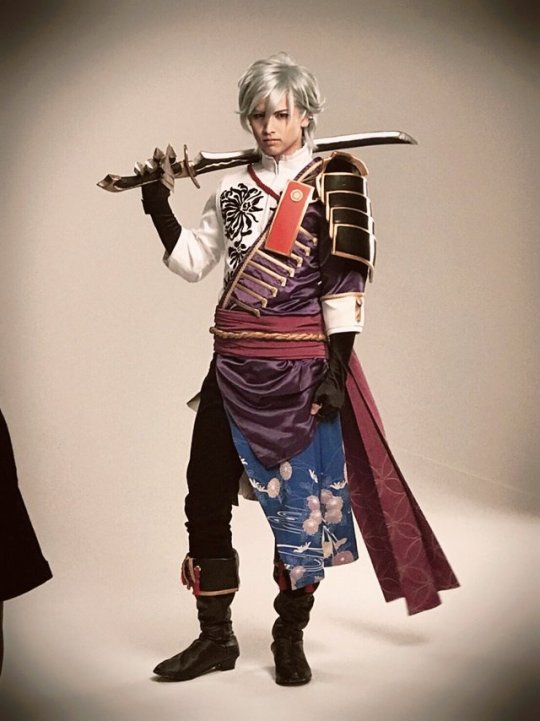
Nagahide Niwa from the Sengoku Night Blood stage play~!
Source
8 notes
·
View notes
Note
Maybe this is unrelated, but this always bugged me. Why a farmer or lower class people usually have "emon" Attached to their name? Is that meaning something or just to indicate that they are a farmer?
Well, I assume you mean in fiction, because I'm not aware of there being a registry of "names of peasants in the Sengoku/Edo period" to be looking at. I suspect that in fiction using "-emon" names is just an easy way to name generic background citizens in period pieces without worrying that you accidentally name them something that's too modern-sounding. It doesn't necessarily mean it's actually accurate or that it has a special meaning to it.
In the Sengoku some samurai also use that naming element, so it's not exactly "a farmer's name" per se.
The element -emon originally came from "emonfu" 衛門府, and this refers to the department of the guards for the outer gates of the imperial palace. As with many of the imperial offices, this department is divided into the "left" and "right", which became the name elements "uemon" 右衛門 (right) and "saemon" 左衛門 (left).
In time both of these just becomes name elements that have nothing to do with the imperial post. Saemon usually becomes -zaemon, as in "Matazaemon" (Maeda Toshiie) or "Gorozaemon" (Niwa Nagahide), and Uemon becomes just -emon. The "u" of Uemon is actually still written in the name kanji, it's just not pronounced (for example, Goemon 五右衛門).
It's true that I don't see the "uemon" one as often as the -saemon in the samurai names that I know of. Naming trends and such is not something I can really speak about, though.
6 notes
·
View notes
Photo










Oh, you poor thing
#sengoku night blood#yuzuki#nagahide niwa#niwa nagahide#niwa#nagahide#shibata katsuie#katsuie shibata#katsuie#shibata#ranmaru mori#mori ranmaru#mori#ranmaru#ep8
17 notes
·
View notes
Photo





#sengoku night blood#yuzuki#ranmaru mori#katsuie shibata#nagahide niwa#vampire#episode 8#otome#otome anime#reverse harem#oda army
17 notes
·
View notes
Photo

Gay husbands shirtless appreciation post
#senbura#senbura anime#senbura oda#sengoku night blood#sengokunightblood#sengoku night blood anime#katsie shibata#shibata katsuie#niwa nagahide#nagahide niwa#oda army#katsuie x nagahide#nagahide x katsuie
7 notes
·
View notes
Photo





#sengoku night blood#oda nobunaga#nobunaga#ranmaru mori#akechi mitsuhide#nagahide niwa#shibata katsuie
13 notes
·
View notes
Text
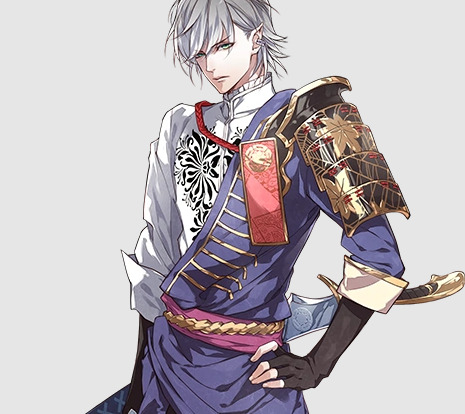
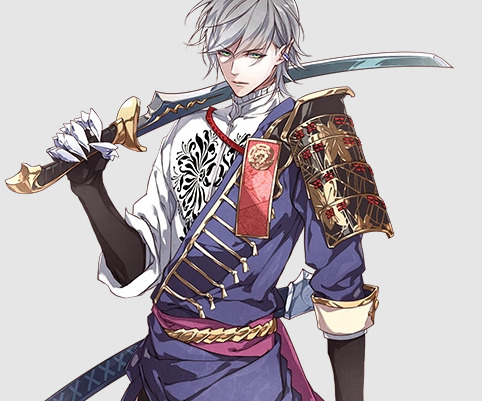
Niwa Nagahide - Sengoku Night Blood
12 notes
·
View notes